Seasonal Journal Autumn 2019
Today is one of those days where I step out of the house and gaze at the sky and the earth and think, “This is one of the prettiest days ever! I am grateful for another day of life on this planet!”
I love all the seasons (although winter gets a bit long here). We are at the peak of foliage season on our small farm in the Northern Mountains. The grasses, mosses and conifers are a still a healing green and the deciduous trees are putting on a spectacular show of yellows, reds, oranges, browns and even purples. Put a bright blue sky as the backdrop for all of that and my heart just leaps with joy.
We’ve had a few frosts already and it won’t be long before we get that deep hard freeze that shuts down all the annuals and puts most of the perennials to sleep for the winter. That means it is time to harvest roots, the cold weather signals the plants to draw their energy into their root system. Roots are at their most nutritious and potent now.
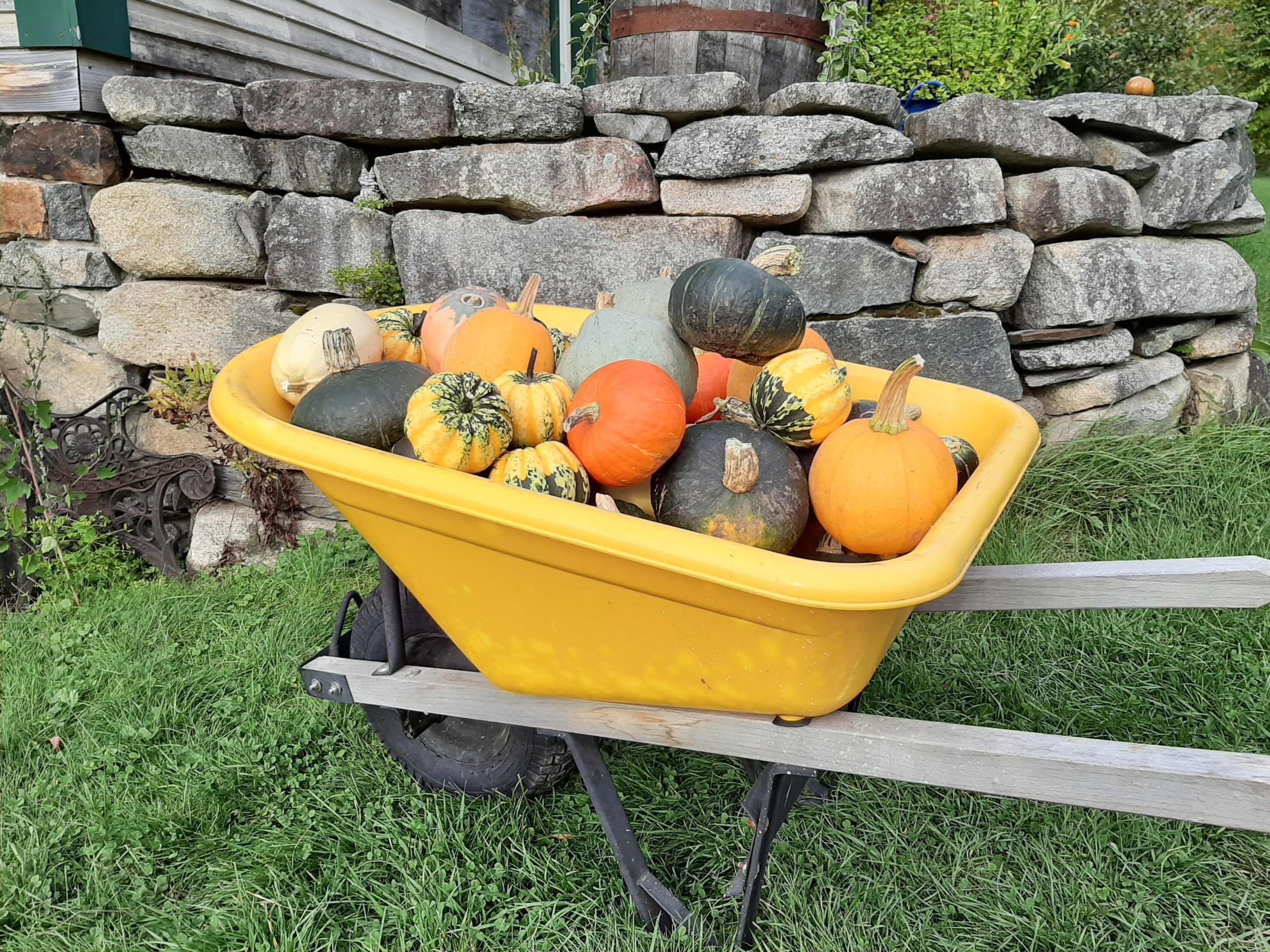
In the vegetable garden…
we are digging the potatoes and storing them in mesh containers in the cellar. We’ll enjoy them all fall and winter and they’ll keep until planting time next year. Carrots, beets, and celeriac are also in the root cellar stored in buckets of sand. Squash and pumpkins are brought into the greenhouse to harden off and sweeten up. Later they’ll get stored under the bed in our cool guest room; around fifty degrees is ideal for storing squash.
Speaking of which, have you been dreaming of something warm and pumpkin spiced? Here is my favorite pumpkin pie (or pudding) recipe. It is always on the menu at Thanksgiving time and I regularly make it without a crust for breakfast on cool fall mornings for a warm and spicy start to the day.
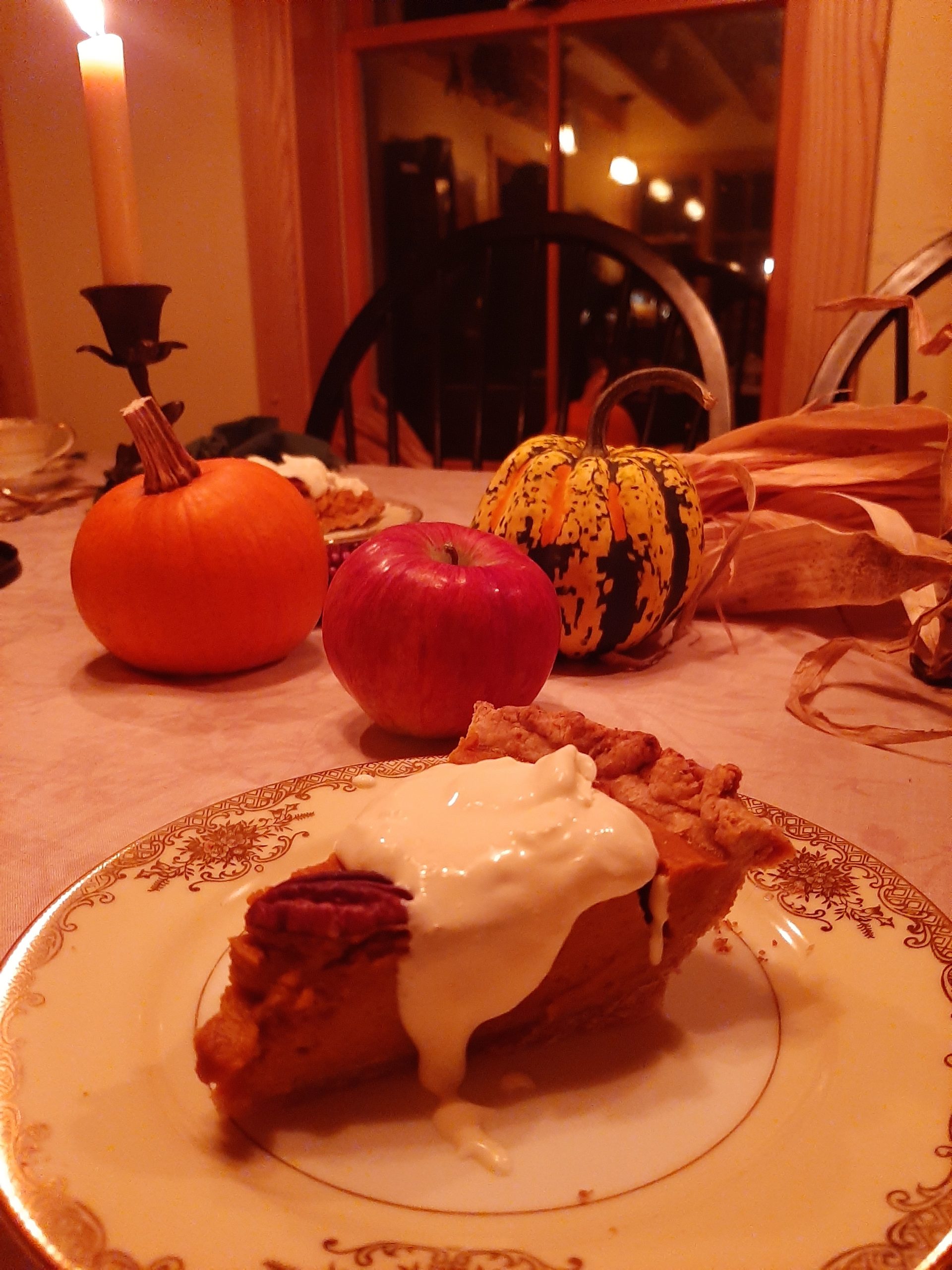
Pumpkin Pie (or Pumpkin Pudding)
You can use a sweet pie pumpkin, winter squash ( I especially like kabocha) or sweet potatoes. They all work great and are full of vitamins and fiber.
- Pastry for a single crust pie (if making a pie) or 4-6 small ramekins for pudding
- 2 heaping cups of cooked pumpkin, winter squash or sweet potatoes
- 3 eggs
- ½ maple syrup (or to taste)
- 1 Tablespoon Black Strap Molasses
- 1 cup of milk (your choice, I’ve use whole cow’s milk or whole coconut milk)
- ¼ teaspoon Celtic or Himalayan salt
- 1 heaping teaspoon each of ground: cinnamon, allspice, and ginger (sometimes I am in the mood for extra ginger, so I add a teaspoon or more of fresh, peeled ginger, too)
If you are making this as a pie, partially bake the pie crust in a 425° oven for about 10 minutes. Let cool. Including this step makes the best pie, but I often skip it and it is still great. If making pudding, get your pudding bowls out and ready.
Put all of the filling ingredients in a blender and puree until smooth. Pour into the pie shell or pudding bowls and bake at 425° for 15 minutes. Lower the heat to 350° and bake another half hour for a pie or if you are doing little pudding bowls just 20 minutes. A sharp knife should come out clean. The top of the pie or puddings will puff up a bit and crack. Serve any temperature plain or topped with homemade whipped cream or slightly sweetened yogurt.
We’ve been enjoying and adapting this recipe for years. It was inspired by our friend and cook extraordinaire, Ken Haedrich. He has some excellent cookbooks. www.ThePieAcademy.com

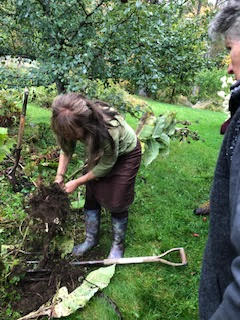
In the herb garden……
today I’m harvesting elecampane and will tincture the roots for the cold and flu season. This hardy tenacious plant is an immune enhancer and effective expectorant. Another healthful fact about elecampane is that it is rich in inulin, a prebiotic fiber that feeds our probiotic gut flora. This helps us have a healthy and happy microbiome, which enhances brain function, digestion, and immunity.
This upper photo is a summer glimpse of elecampane, now that it is fall the flowers have turned to seeds and the leafy parts are dying back leaving most of the energy in the roots.
Elecampane is a very rewarding plant to grow, partly for its rugged beauty but also because the roots are quite big after just two years. One tip for preserving big roots like this is to clean the roots well right away and chop them up soon. Once they dry they are hard to chop. I like to keep some dried in the apothecary for tea and also tincture some fresh.
I’m waiting for a hard freeze to harvest echinacea root and seed to tincture for the antimicrobial properties. Earlier this summer I harvested the leaves and flowers of echinacea and tinctured them. Later I will combine the two tinctures for a whole plant remedy. We use echinacea for infections, and especially at the onset of colds and flu symptoms. Some of the other roots on the list to harvest before the snow falls are burdock, ashwaganda, black cohosh, valerian, and marshmallow. Having the root cellar full of veggies, and the apothecary full of herbs is comforting.
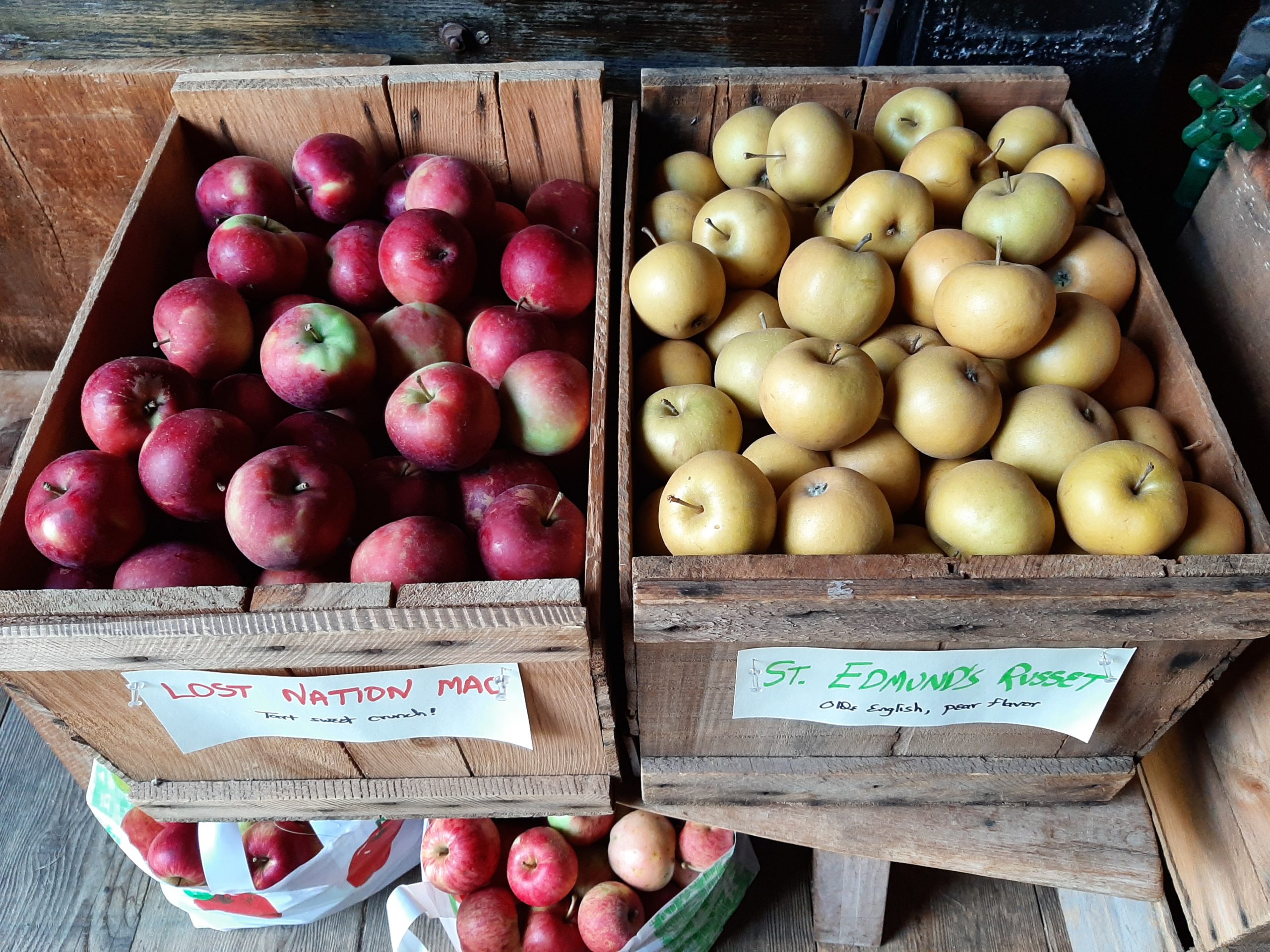
Fall means apple season here at Heartsong Farm!
Michael has been planting and cultivating apple trees here for over 30 years and now has more than 100 varieties. Every time I say that, I think,“ Is that really true, over 100?” It is.
That is quite a difference than the few varieties we can generally buy in our local grocery store. Many of the varieties we grow are old heirloom types that are naturally more disease resistant, full of unique flavor, and nutrient dense. This week Michael has been harvesting Sweet 16s, Honey Crisps and Wealthy. Yum!
Michael is known for growing delicious fruit without harmful chemicals. This is for our health and our customers. Just as important, we love our land and the life that abounds above and beneath it. Why would we want to put harmful chemicals into the soil, our water systems, or cause death to our local pollinators and other creatures that share this place on the planet? We strive to live in harmony with the earth and all creatures as much as possible.
If you are familiar with the “Dirty Dozen” and “Clean Fifteen” from the Environmental Working Group you may already know that conventionally grown apples have been on the “Dirty Dozen” list since its inception. Basically, this means that apples are one of the crops that are grown with a high amount of pesticides. Rinsing is said to have little effect on removing apples’ long list of pesticide residues, according to the EWG. Conventionally-grown apples are typically treated with a chemical called diphenylamine, which helps to preserve the color of the skins during storage. Peeling the skin may help remove this chemical, but this is also where much of the apple’s nutritional benefits lie. Stick to organic—and consider organic varieties of apple juice and applesauce, too.
It would be ideal if everyone could grow their own fruits and vegetables or buy everything local and organic, but this isn’t always an option. The “Dirty Dozen” and “Clean 15” lists help us prioritize. Choose local and foods grown in harmony with the earth when possible, but if you can’t always, these lists can help guide you to less harmful choices.
The Environmental Working Group (EWG), a nonprofit organization dedicated to protecting human health and the environment, crafts the annual “Dirty Dozen” list to show consumers the fruits and veggies they should buy organic when possible. https://www.ewg.org/foodnews/faq.php
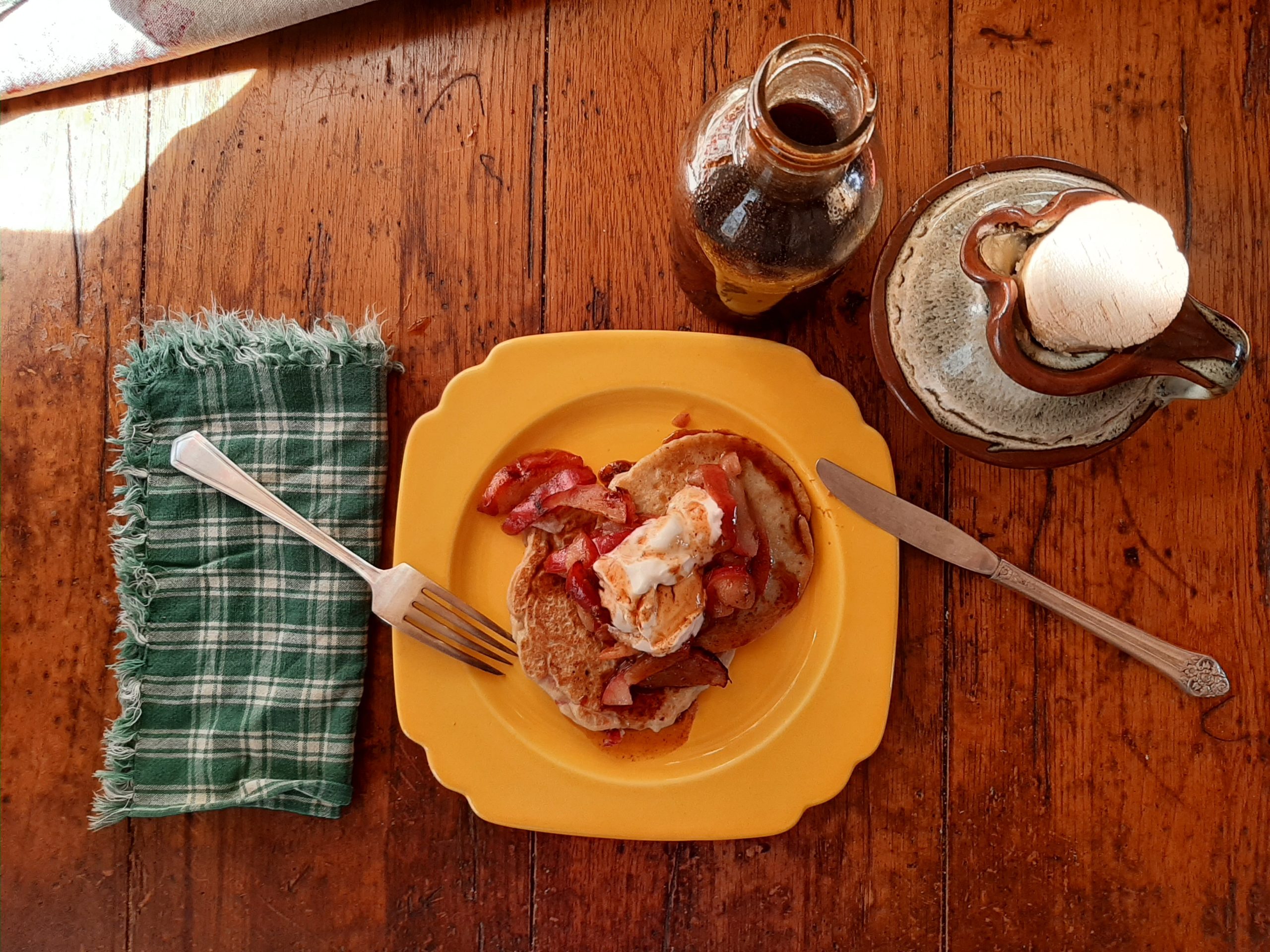
From an Ayurveda perspective…….
fall is the vata time of year which relates to the elements of air and space. The dry wind and coolness can make us feel scattered and unsettled like falling leaves. Starting our day with something warm and comforting is grounding and keeps our inner fires burning. Now is not the time of year to be dropping frozen fruits and cold yogurt into a blender to start your day with an icy smoothie. That would dash out any inner fire you have going in the morning, making you feel tired and depleted before you barely get going. Oatmeal and other cooked grains with warming spices and protein rich seeds like flax and chia are ideal. Eggs and veggies are also standbys at our house. I love warm soup for breakfast too. Soup for breakfast is a bit atypical, just give it a try and see how you feel.
Oh, but my favorite is pancakes! I like to pile them with cooked apples, pecans, yogurt and local maple syrup. Unfortunately (for me and many others) after eating a breakfast like this my blood sugar shoots up and I just feel lethargic and sleepy. So here is my new favorite, high protein, simple pancake recipe (just three ingredients). Because they are higher in protein then the typical pancake and lower in processed flour and sugars they leave you feeling light and energized.
These quinoa pancakes are simple to make, delicious, and high in protein. You can eat them topped with cooked spiced apples. I still like them with a small splash of good quality local maple syrup or homemade apple cider syrup (see recipe below). These are also great as a savory dish with sautéed vegetables.
Quinoa originally grew wild in the Andes Mountains of South America and was cultivated as early as 5000-3000 B.C. There are many good reasons that it has remained a staple part of Andean cuisines from that time. The high protein content of quinoa and its high amino acid composition make it a fantastic source of plant protein for any meal. 3/4th cup of quinoa provides 8 grams of protein – very similar to 1 cup of yogurt, and about double the amount of protein in an equivalent amount of wheat or brown rice. (Coming soon I’ll send you a delicious recipe from our dear Ecuadorian friend, Rocio, an Andean soup recipe with quinoa, potatoes and peanuts. Yum!) We usually serve it at our “Healing the Healers” retreat in late August.
Apple Cider Syrup
So yummy and easy to make! Apple cider syrup is sweet and tangy and can be used in so many ways. I like to substitute part of the sugar in pies and apple crisps with the syrup. You can easily make a great vinaigrette with it and it is perfect for drizzling over roasted vegetables and simple desserts. Apple cider syrup is bright and zippy and can be used in place of lemon in some recipes. I put a dash in coleslaw and love it in sweet and sour cooked cabbage.
Start with a gallon of flavorful apple cider. Put it in a deep pan with a wide bottom to maximize evaporating. Bring to a low boil. The time will vary on how long to boil it, but it will probably take around an hour and a half. Watch it closely towards the end. Use a candy thermometer, when it reaches 220°-225°, it is done. If you heat it more it will turn into a product more like molasses. Pour the hot syrup into a sterilized canning jar. It will keep will in a cool spot for months or even longer.
Quinoa Pancakes with Apple and Cider Syrup
Serves: 5 (8-10 pancakes)
Prep Time: 10 minutes plus overnight soaking
Ready In: 25 minutes
Ingredients
4 ½ cups water (more or less)
2 cups quinoa
1 teaspoon salt
1 cup shredded apple (optional)
2 Tablespoons coconut oil or ghee
Directions
- Place the quinoa in a large bowl and cover with 4 cups of water. Let the quinoa soak overnight or all day, for at least 8 hours.
- Drain and rinse the quinoa well. (Quinoa has saponins which taste a bit soapy if you don’t rinse it well.) Place the rinsed and drained quinoa into a blender or Vitamix (you might have to do it in two batches if using a blender).
- Add 1/2 cup fresh water and 1 teaspoon salt, then grind. The consistency should look and feel just like pancake batter, not too thick and not too thin.
- If needed add more water and grind again until the consistency is right.
- Melt the coconut oil over medium heat in a large, wide skillet.
- When the oil is hot, pour 1/4 cup of the batter into the skillet. Cook for about 1 1/2 minutes, or until the batter bubbles a little in the center and the edges turn a golden brown. Turn the pancake over and cook for another minute, or until the color is golden brown on the second side.
- Serve with maple syrup, cider syrup or cooked apples!
They seem best right off the skillet, if you don’t want to use all the batter, just store it in a jar for up to a week and make them as needed.
This recipe was inspired by Talya, Ayurveda teacher, author and cook. https://www.talyaskitchen.com
